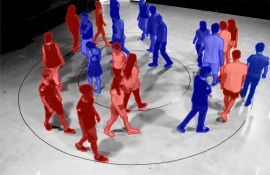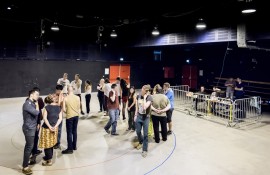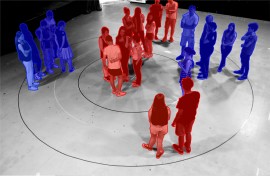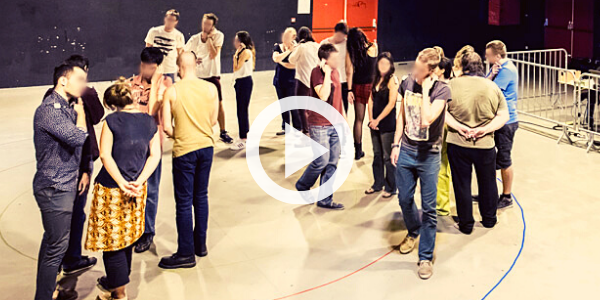Monday, July 27, 2020 - Toulouse. A French research team in biology, economy, computer science, and physics discover how social information drives the segregation dynamics and fragmentation of human groups.
In our societies, the development of the Internet, social media, and mobile technologies have deeply changed the way people communicate. Today, individuals massively interact through digital interfaces that impact the collective behavior and the level of polarization of groups. Many social media networks like Facebook or Twitter use automatic filtering algorithms and recommender systems that provide different and tailored information to individual users. While useful, these social media filters have also contributed to the amplification of homophily and the tendency of individuals to selectively expose themselves to the opinion of like-minded people, thus reinforcing their existing beliefs.
This raises concerns that information technologies can eventually lead to increasingly polarized and fragmented societies. Interestingly, the formation of polarized groups as a consequence of information filtering displays many similarities with the phase separation of two immiscible materials in physical and biological systems. Yet, an important issue that has received little attention so far is how the amount of information perceived and used by individuals impacts the segregation dynamics and the resulting fragmentation of groups.
To investigate this question, biologists, economists, computer scientists, and physicists from IAST, TSE, CRCA, LAAS, and LPT performed a series of experiments with human groups that mimic the tendency of individuals to bond with other similar individuals. The participants were randomly assigned a color (red or blue), and had to regroup with other subjects sharing the same color. However, nobody knew his own color nor that of the other participants. To assist them in this task, the participants were equipped with a fully controllable artificial sensory device that filtered and adapted in real-time the information that was delivered to them; so that their decision to stop or resume walking only depended on whether or not the majority of their k nearest neighbors was of the same color as them. The value of k was controlled by the researchers and only known to them. The participants being unaware of the actual nature of this control, this experimental setup allowed the researchers to precisely investigate the impact of the amount of information available to the participants about their environment on the separation process and the final state.
The results of the study conducted by Jayles, B., Escobedo, R., Pasqua, R., Zanon, C., Blanchet, A., Roy, M., Tredan, G., Theraulaz, G. & Sire C. were published in the Philosophical Transactions of the Royal Society of London and showed that the amount of information collected at the individual scale deeply affected the collective separation dynamics and the resulting final state observed at the group level. More importantly, the research team explained that their experiments and data-driven modeling approach demonstrated that there exists a maximum amount of information (corresponding to a value of k = 7) beyond which the acquisition of additional information at the individual level does not improve the level of segregation of the group and that this limitation is not the consequence of information overload.
This multidisciplinary research illustrates how the choice of the information delivered to a human group allows controlling the dynamics and the resulting final state of the group, even when the individuals are not aware of the precise nature of the information they were provided. This result echoes the issue of controlling the excessive polarization of human groups in many social contexts, in particular, due to information filters.




Pictures: top left and bottom left: in the segregation experiments, the tag clipped on each participant's left shoulder beeps if the color of the majority of his/her k nearest neighbors (k = 1, 3, 5, 7, 9, 11 and 13) is different from his/ her own. The positions of the participants are recorded in real-time by a tracking system based on the triangulation of sensors located around the arena (picture by David Villa, ScienceImages, CBI, CNRS, Toulouse).
Top right and bottom right: illustration of two stages of an experimental run; top right: random walking phase and bottom right: final silent state where the subjects do not beep and do not move anymore (picture by Guy Theraulaz, CRCA, CBI, CNRS, Toulouse).
Video produced by David Villa, ScienceImages, CBI, CNRS, Université Toulouse 3 Paul Sabatier, Toulouse and music ©Efiel - Jamendo.
The study was carried out as part of the Multi-Disciplinary Study of Emergence Phenomena (IDEX-0002-02–Transversalité), and SmartCrowd supported by the interdisciplinary mission of the CNRS (Défi Sciences Sociales et Cognitives des Comportements Collectifs).
About the authors
Adrien Blanchet is a mathematician specialized in partial differential equations, calculus of variation, and optimal transport, he is a member of Toulouse School of Economics and IAST. He applies his research to social sciences and economy and focuses on the understanding of emergence phenomena.
Bertrand Jayles is a Research Fellow at the Max Planck Institute for Human Development, his research focuses on the mechanisms underlying social influenceability and how social information exchange shapes individual and collective decisions. His work closely combines theoretical and experimental approaches, with strong data analytics and computational modeling components.
Ramón Escobedo is a mathematician interested in data analysis and mathematical modeling of collective behaviors in animal an human groups. He works at the Research Center on Animal Cognition.
Roberto Pasqua works at LAAS-CNRS and his research interests include the study of distributed and mobile networks. He previously worked on privacy protection and studied computer science and system engineering.
Matthieu Roy is full-time researcher at LAAS-CNRS since 2004. His research interests lie in distributed systems, embedded systems, and particularly human-centered networking. He has contributed/leaded several european projects and national projects on privacy, embedded systems, distributed systems and is currently the scientific co-leader of the SOUK platform, developed to study the interrelationships between social and spatial behavior.
Clément Sire is a mathematician, physicist and CNRS resarch director, after a Ph.D. on the electronic properties and the stability of quasicrystals (1990; ENS Paris & Univ. P. & M. Curie), Clément spent two years at the AT&T Bell Labs (NJ, USA)where he worked on high-Tc superconductivity and also started working on nonequilibrium statistic physics, which has since become his main domain of research: stochastic processes and their physical applications, phase separation and coarsening systems, physics of society, and behavioral biology.
Guy Theraulaz is a CNRS Research Director at the Research Center on Animal Cognition and member of IAST. He is an expert in collective and swarm intelligence. His research focuses on the understanding of a broad spectrum of collective behaviours in animal societies and human groups by quantifying and then modelling the individual level behaviours and interactions, thereby elucidating the mechanisms generating the emergent group-level properties.
Gilles Tredan is a researcher in the Critical Computing Department of LAAS-CNRS. His main research interests include human-centered systems, networks and distributed systems. He is currently the scientific co-leader of the SOUK platform, developed to study the interrelationships between social and spatial behavior.
Christophe Zanon is research engineer at LAAS-CNRS, he has been a principal developer in several European and national projects, his main interests are privacy, access control schemes, and mobile systems




Add new comment